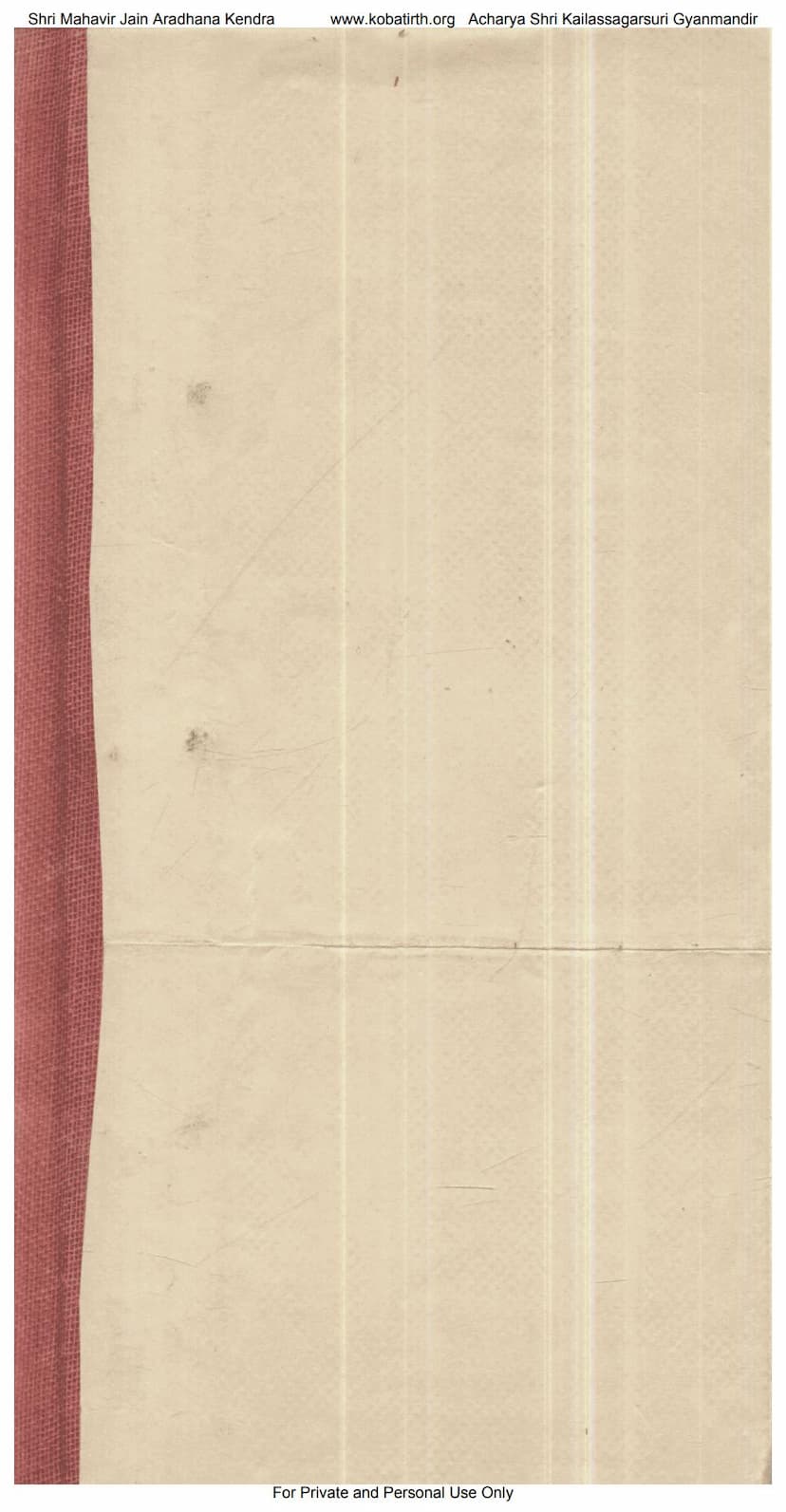Daivat Bramhanam Tatha Shadvinshat Bramhanam
Added to library: September 1, 2025

Summary
This document is the title page and preface for the book "Daivatabramhana and Shadbingshabramhana of the Samaveda" with the commentary of Sayana Acharya, edited and published by Pandit Jibananda Vidyasagara in 1881.
Here's a summary of the provided pages:
-
Page 1-2: These pages contain the initial identification of the book, its author (Sayana Acharya's commentary), editor/publisher (Pandit Jibananda Vidyasagara), and the fact that it's the "Second Edition" published in Calcutta in 1881. It also mentions the "Shri Mahavir Jain Aradhana Kendra" and its website, indicating a connection to Jain educational resources. The text "For Private and Personal Use Only" is repeated, emphasizing its restricted distribution.
-
Page 3: This page lists a vast catalog of other Sanskrit books published or available, ranging from grammar and literature to philosophy, medicine, and drama. This gives context to the publisher's extensive work in making classical Indian texts accessible.
-
Page 4: This is the formal title page in Sanskrit, confirming the text being "सामवेदस्य देवतब्राह्मणम् । तथा षडविंश ब्राह्मणम् । सायणाचार्य कृतभाष्यसहिम् ।" (Daivatabrahmana and Shadavimsha Brahmana of the Samaveda, with the commentary of Sayana Acharya). It further details the publisher "श्रीजीवानन्द विद्यासागर भट्टाचार्येण" (by Jivananda Vidyasagara Bhattacharya) and the printing location "कलिकातानगरे सरस्वतोयन्त्रे" (in Calcutta, at the Saraswati Press). The year is given as "१८८१" (1881).
-
Page 5-23: These pages contain the preface (भाष्यकृतोमिका) and the beginning of the Daivata Brahmana section.
- The Preface (page 5) begins with invocations to Gajanana (Ganesha) and Vidya-tirtha Maheshvara, and acknowledges Sayana Acharya's role in interpreting the Vedas. It mentions that Sayana Acharya has already commented on the Yajurveda and Samaveda Samhita and is now commencing the commentary on the Brahmanas. It lists eight Brahmanas of the Samaveda, including the Praudha Brahmana, the Shadavinsha Brahmana, Samavidhi, Arsheya, Daivata Adhyaya, and Upanishad, indicating that this edition covers the Daivata Adhyaya and Shadavinsha Brahmana. The preface then proceeds to explain the structure and nomenclature of the Daivata Brahmana, focusing on the classification of Saman hymns based on their nidhana (ending portion) and associated deities.
- The Daivata Brahmana proper begins on page 6, detailing the deities associated with various Saman hymns. It systematically lists Saman hymns classified by their nidhana (e.g., Ida-nidhana, Pada-nidhana, Ikara-nidhana) and then by their associated deities (Agni, Indra, Prajapati, Soma, Varuna, Tvashta, Angiras, Pusha, Saraswati, Indragni). It explains the technical terms related to Saman chants and their classification. It also discusses different categories of deities associated with Samans based on the structure of the hymns.
- Pages 12-23 cover the subsequent sections of the Daivata Brahmana, discussing the deities associated with meters (chandas) and the specific colors associated with these meters, and then detailing the etymology and meaning of various meters like Gayatri, Ushnik, Kakubh, Anushtubh, etc., often referencing Brahmans or traditional interpretations.
-
Page 24-56: These pages begin the commentary on the Shadavinsha Brahmana.
- The text starts with Om Namah Samavedaya.
- The first section (प्रथमो प्रपाठकः) discusses the ritualistic aspects of the Subrahmanya chant in the Soma sacrifice, its relation to Indra and other deities, and the associated mantras and their significance. It delves into the origins and meanings of the terms and the practical application of these chants by the priests (Hotri, Adhvaryu, Brahmanya, Udgata).
- It elaborates on the role of the Subrahmanya chant in invoking deities, its gendered association (male, female, neuter), and its connection to the three Vedas (Rig, Yajus, Sama).
- Later sections (प्रपाठक २ onwards) discuss various rituals, sacrifices, and their symbolic meanings. This includes the performance of the Pratah-savana (morning libation), Madhyandin-savana (midday libation), and Tritiya-savana (third libation), and the specific chants and deities associated with each.
- It delves into details of purification rituals, offerings, and the significance of different verses and meters in the context of the sacrifice.
- The text also covers topics like the influence of celestial bodies (moon phases), omens and their interpretations, and specific rituals to ward off evil or achieve desired outcomes, often linking these to particular deities and Saman hymns.
- It discusses the significance of the Yupa (sacrificial post), its construction, and associated deities.
- The text also includes rituals related to Sandhya (twilight), and the lunar phases.
- It further details various Abhichara (sorcery or imprecation) sacrifices, like the Shyena Yaga (Hawk sacrifice), Sandaṁśa Yaga (Tongs sacrifice), and Vajra Yaga (Thunderbolt sacrifice), which are performed to destroy enemies or achieve specific goals. These sections often explain the symbolic meanings of the rituals and the associated Saman chants.
-
Page 57 onwards: The remaining pages are the start of the commentary on the Shadavinsha Brahmana, with the initial sections of the commentary on Subrahmanya and subsequent rituals. The commentary is very detailed, explaining the context, mythology, and ritualistic performance of each element.
In essence, the document is a scholarly edition of two significant Brahmanas of the Samaveda, offering the interpretation of the influential scholar Sayana Acharya, made accessible through the efforts of Jivananda Vidyasagara. The content focuses on the ritualistic, mythological, and symbolic aspects of Vedic sacrifices as described in these Brahmanas.